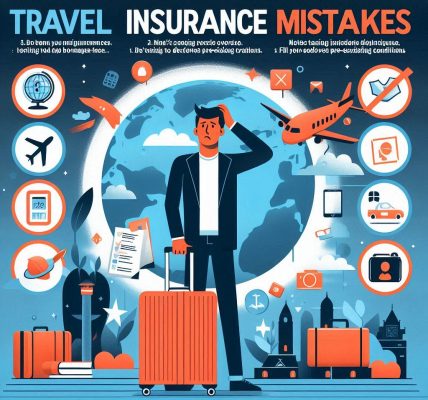Introduction
Traveling to new destinations is exciting, but unforeseen medical emergencies can turn a dream trip into a nightmare. Medical expenses abroad can be exorbitant, and without the right financial protection, travelers may face substantial financial burdens. Travel insurance acts as a safety net, ensuring that you receive necessary medical care without depleting your savings.
In this DIY guide, we will explore how travel insurance protects you from unexpected medical expenses while traveling internationally. We will also discuss what to look for in a policy, how to file a claim, and best practices to ensure a smooth experience.
Why Medical Coverage in Travel Insurance is Essential
1. High Medical Costs in Foreign Countries
Medical expenses vary across countries. In destinations like the U.S., Canada, or Switzerland, even a minor hospital visit can cost thousands of dollars. Travel insurance helps cover:
- Emergency room visits
- Hospitalization costs
- Doctor consultations
- Surgery expenses
- Ambulance services
- Medication costs
2. Protection from Unexpected Illness or Injury
Accidents or sudden illnesses can occur anytime. From food poisoning to broken bones, having travel insurance ensures you receive proper treatment without financial stress.
3. Emergency Medical Evacuation
If you require medical treatment unavailable at your travel destination, emergency medical evacuation covers:
- Transportation to the nearest hospital with proper facilities
- Air ambulance services
- Repatriation to your home country if necessary
4. Pre-Existing Conditions Coverage
Some policies offer coverage for pre-existing medical conditions. It’s crucial to check the policy details, as not all insurers provide this coverage automatically.
5. 24/7 Assistance Services
Most travel insurance providers offer 24/7 assistance, helping travelers locate hospitals, arrange transportation, or even provide language translation services in medical emergencies.
How to Choose the Right Travel Insurance Policy
1. Coverage for Medical Emergencies
Ensure the policy covers hospitalization, outpatient treatment, emergency evacuation, and repatriation. A minimum coverage of $50,000–$100,000 is recommended for international travel.
2. Policy Exclusions
Every policy has exclusions. Common exclusions include:
- Injuries due to reckless behavior (e.g., extreme sports, alcohol influence)
- Cosmetic procedures
- Routine check-ups
- Pre-existing conditions (unless covered explicitly)
3. Network Hospitals and Cashless Facility
Check if the insurer has a network of hospitals in your travel destination. Many insurers offer cashless hospitalization, eliminating the need for upfront payments.
4. Claim Process & Documentation
Opt for an insurer with a hassle-free claim process. Check:
- Required documents (hospital bills, doctor’s reports, prescriptions)
- Claim filing deadlines
- Online claim filing options
Steps to File a Travel Insurance Claim for Medical Expenses
Step 1: Inform Your Insurer Immediately
As soon as you need medical assistance, contact your insurer’s emergency helpline. Provide policy details and describe the situation.
Step 2: Seek Medical Attention at Approved Facilities
If your policy includes a network of hospitals, visit an approved medical facility to simplify claims processing.
Step 3: Collect Necessary Documents
To file a claim successfully, keep:
- Medical reports
- Hospital bills and receipts
- Doctor’s prescriptions
- Diagnostic test results
- Any other relevant medical documents
Step 4: Submit the Claim Form
Complete the insurer’s claim form and attach supporting documents. Most insurers allow online submissions for faster processing.
Step 5: Follow Up on Your Claim
Stay in touch with the insurance provider to track claim status and address any additional requirements.
Best Practices to Maximize Your Travel Insurance Benefits
1. Read the Policy Terms Carefully
Understanding policy terms helps avoid claim rejections. Look for:
- Inclusions and exclusions
- Coverage limits
- Claim procedures
2. Disclose Pre-Existing Conditions
Hiding pre-existing medical conditions can lead to claim denials. Always provide accurate health information when purchasing insurance.
3. Carry a Copy of Your Insurance Policy
Keep a digital and physical copy of your insurance policy, emergency contact numbers, and claim process details handy.
4. Choose a Reputable Insurance Provider
Go with well-known travel insurance providers with a good claim settlement ratio and positive customer reviews.
5. Inform Travel Companions
If traveling with family or friends, ensure they know your insurance details in case of emergencies.
Conclusion
Medical emergencies can happen anywhere, and being unprepared can result in significant financial stress. Travel insurance acts as a financial shield, covering unexpected medical expenses, hospitalization, and emergency evacuations. By choosing the right policy, understanding the claim process, and following best practices, travelers can ensure a stress-free experience abroad.
Investing in a comprehensive travel insurance policy isn’t just a precaution—it’s a necessity. Before your next trip, take the time to compare policies and select one that best suits your needs. Safe travels!




